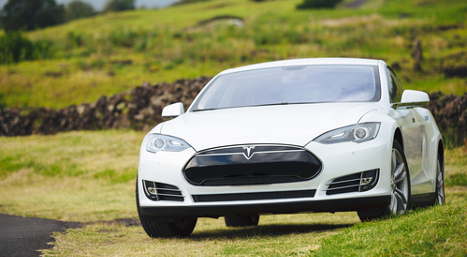Electric Vehicles Remain Mostly ‘Soft’ in Used Market

The Telsa Model S continues to see much stronger price retention than the marjority of electric vehicles.
By subscribing, you agree to receive communications from Auto Remarketing and our partners in accordance with our Privacy Policy. We may share your information with select partners and sponsors who may contact you about their products and services. You may unsubscribe at any time.
McLEAN, Va. –
For the most part, used electric-vehicle prices continue to be very soft, a trend that has remained pretty steady over the past couple of years and has been compounded as of late due to low gas prices.
And with many of the newer model-year EVs, such as the 2014 Chevy Volt, set to hit the used market in droves this year, this may provide some cheap options for consumers with fuel-efficiency top-of-mind.
One problem — the consumer demand might not be there. Larry Dixon, senior manager of market intelligence at NADA Used Car Guide, said, “Used EV demand continues to be hampered by range and technology concerns, as well as by stiff competition from highly efficient — and more affordable — gasoline-powered cars.”
And the fact that gasoline prices are about $1 less than they were this time last year certainly plays a role in shifting consumer attention away from these fuel-efficient — but pricey — models.
“Substantially lower gasoline prices make it even more difficult to justify an EV purchase from an economic standpoint. Again, lower gas prices combined with ongoing gains in gas-powered vehicle efficiency makes EVs an even harder sell,” Dixon explained.
Looking at specific price movement to illustrate overall softness in the market, take these statistics into account:
Subscribe to Auto Remarketing to stay informed and stay ahead.
By subscribing, you agree to receive communications from Auto Remarketing and our partners in accordance with our Privacy Policy. We may share your information with select partners and sponsors who may contact you about their products and services. You may unsubscribe at any time.
According to NADA data, trade-in values for 2011 to 2013 model-year EVs, such as the Nissan Leaf, Chevy Volt and Ford C-Max, fell by 25 to 35 percent from the first quarter of 2014 to the Q1 of this year.
By comparison, trade-in values for gas powered compact and midsize cars fell by an average of 15 percent over the same period, Dixon pointed out.
Bucking the Price Trends
With this poor performance in mind, the players bucking the trends stand out quite a bit, or as Dixon puts it: “The strong EV performers stand out more than weaker ones since the majority is underperforming at the moment.”
One example is the Tesla Model S, whose values have held up very well so far. According to NADA data, used value retention for the 2012 Model S with the 86 kilowatt-hour battery stands at about 57 percent retention, which Dixon pointed out is on par with the 2012 Porsche Panamera’s retention of 62 percent.
In comparison, retention for the 2012 versions of the Chevy Volt and Nissan Leaf is around 35 percent and 27 percent, respectively, according to NADA data.
“As long as there is an air of exclusivity, values for vehicles like the Model S and Panamera e-hybrid will likely outperform those of the competition,” Dixon said.
The Strongest Players|
Moving beyond price and taking a look at consumer demand in the luxury EV market, in this instance, Tesla and BMW stand out.
“Tesla’s new-vehicle sales and used-value retention have been solid to-date, and while it’s still early, sales of BMW’s i3 compact EV are off to a strong start,” said Dixon. “Per Wards Auto, BMW delivered nearly 2,700 new i3s in the first quarter of 2015, which was 12 percent of all EV sales.”
Dixon traces Tesla and BMW’s strength in the EV market to their luxury status.
“For example, Tesla’s Model S is an expensive luxury vehicle purchased by affluent consumers and demand for the model has been predicated on owning a vehicle an aura of exclusivity,” said Dixon. “Luxury vehicles often do not compete with the larger pool of mainstream, gasoline powered substitutes, but rather a rarer group of more technologically advanced performance models."
As for what pushes demand on the more inexpensive models, such as the Volt and Leaf, Dixon said consumer interest focuses on more practical factors, such as upfront costs, maintenance/repair costs, price among the competition, overall range, real-world practicality and gasoline prices.
“Simply put, competition for mainstream models has been much fiercer than for luxury models, hence their lower retention rates,” Dixon concluded.
The Tesla Anomaly
The Tesla Model S, in particular, is low on competition. And compounding this is the fact that the number of these units running through the lanes has been small — which also supports stronger used prices, Dixon said.
“We’ve recorded approximately 100 Model S sales (all model years) through our AuctionNet auction network to-date. Judging by the Model S’ solid retention, consumer reception has been strong,” said Dixon.
And right now, there are few used luxury competitors to the Model S. The 2014 Cadillac ELR, for example, isn’t holding retention like the Model S, retaining only 58 percent of its value.
“By comparison, retention for the 2014 Model S with the 85 kilowatt-hour battery stands at roughly 83.7 percent,” said Dixon. “Retention for the 2014 Porsche Panamera S e-Hybrid 3.0L V6 is 79 percent, not too dissimilar from the Model S.”


